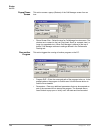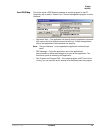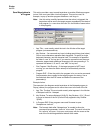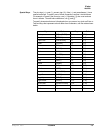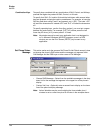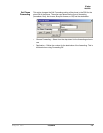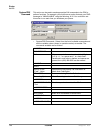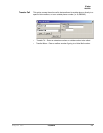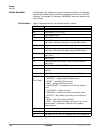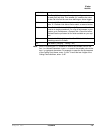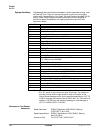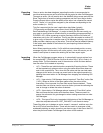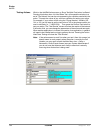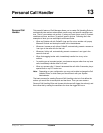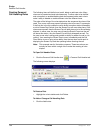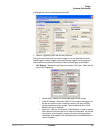
IPedge
Actions
148 TOSHIBA
IPedge UG 06/11
Action Variables Call Manager uses variables to provide information to actions. Call Manager
replaces the variable token code with the appropriate value when the action
executes. For example, %P becomes ‘4804969040’ when you receive a call
from Toshiba.
Call Variables Refer to the table below for call variables and their values.
Variable Information
%A Account Number
%B Call Direction (“In” or “Out”)
%C DNIS Called Name
%D DNIS/DID Number
%E This Call Manager’s Extension Number. (Can be used for Pri-
mary DN or Secondary DN when using Set DND Action.)
%F Call Forwarded from Extension number
%G DND Message, when phone is in DND. (Can be used for Pri-
mary DN or Secondary DN when using Set DND Action.)
%H Calling Number (hyphenated – type 1, format defined in
agnt_ph.ini)
%I TAPI Call ID
%J Calling Number (hyphenated – type 2, format defined in
agnt_ph.ini)
%L Elapsed Time of Call (H:MM:SS)
%M Main Listed Phone Number (Use with Export Call Info
actions)
%N CallerID Name (outside calls only, requires CallerID)
%OR(“field”)
or
%OC(“field”)
Outlook Calendar/Reminder “fields”:
1. “SUBJECT” – subject field of Outlook event.
2. “START” – start Date/Time of event.
3. “END” – ending Date/Time of event.
4. “IMPORTANCE” – Importance (Low, Normal, High) of
event.
5. “LOCATION” – location of event.
6. “ADVANCE” – number of minutes of advance notice.
7. “STATUS” – Busy status (Free, Busy, Out of Office) of
event.
8. “STIM” – start Time without the Date.
9. “DIFF” – time difference before event start, e.g., 15 min-
utes will report “15 Minutes”. Used for text to speech
announcments.
%P Incoming: CallerID Number / ANI; Outgoing: Dialed Number
%S Call Answered (“Y”es or “N”o)
%T Call Type (“IC” or “CO”): IC= Intercom call; CO= Outside call.



